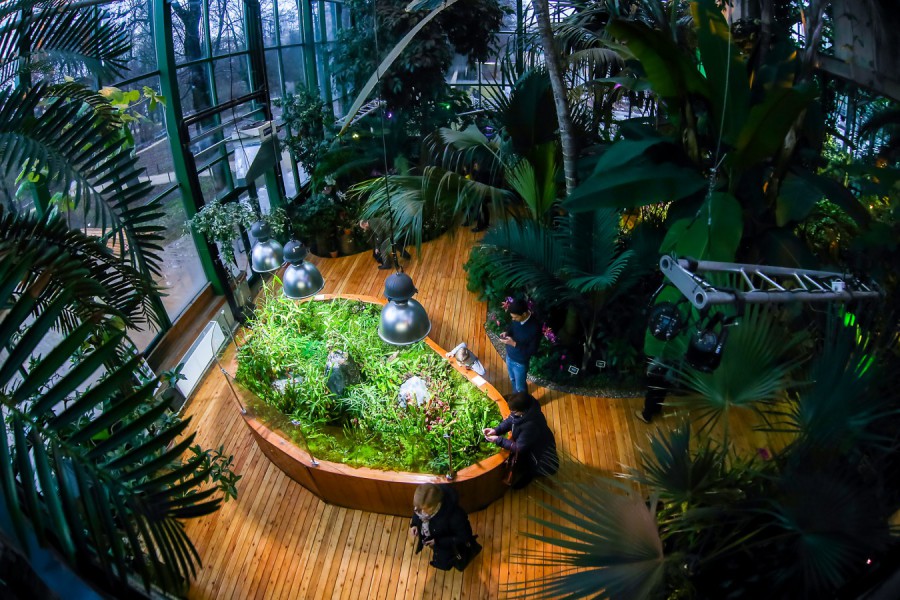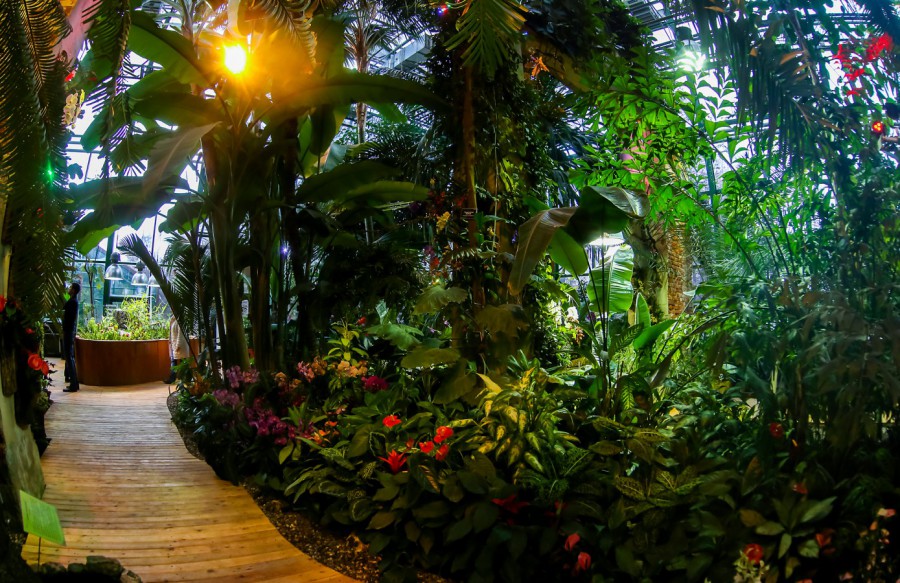text and photo: Main Botanical Garden named after. N.V. Tsitsin RAS
Chinese orchids – cymbidiums(Cymbidium Sw.) - are the main exhibits of the orchid exhibition " Blooming Garden", prepared in the old Stock greenhouse of the Main Botanical Garden named after. N.V. Tsitsina Russian Academy Sci.
The exhibition opened on January 20, 2017, on the eve of the New Year. eastern calendar, and will end its work on March 31.
The stock greenhouse of the Main Botanical Garden invites plant lovers to the exhibition of orchids “Blooming Garden”.
Cymbidiums, Lan plants, Ribbon grass in China
In the vast world of natural orchids, they are famous for their large, charming flowers, which are characterized by a subtle, pleasant aroma.
The culture of Cymbidiums and the enjoyment of these unique orchids go back centuries. The first literary mentions of cymbidiums - large-flowered orchids, or "Lan" plants - were found in the oldest monument of Chinese classical literature“Book of Poems” (“Shin Ching”, 8th century BC). Here, in the ballad about “Ribbon Grass” (this is the second name for the “Lan” plants), the wonderful aroma of blooming cymbidiums is praised and the incense “lan” is spoken of.
Even in ancient China, they noticed that cymbidium flowers emit aroma mainly in the morning.
There were two periods of enjoying Lan plants:
– in the morning – for the sake of aromas;
– the rest of the time – we admired the beauty of orchid flowers.
The ancient Chinese philosopher Confucius (551-479 BC), who was well acquainted with the properties of wild orchids in China, mentioned the “Lan” grass more than once.
Confucius wrote about the influence of Lan plants on achieving internal harmony of the individual, and compared the effect of cymbidiums on a person with the influence of good music.
Since the time of Confucius in China, parallels have been drawn between enjoying the aromas of cymbidiums and beneficial communication with good old friends.
In the literature, Lan plants are accompanied love relationships; they symbolize inspiration, poetry, emotional experiences.
In Chinese traditional painting, the cymbidium orchid is one of the four noble plants, along with and plum (). Cymbidium symbolizes conciseness and modesty, these are important qualities of a “noble husband” - an ideal state to strive for.
All noble plants appear on modern Chinese coins. Thus, the orchid is minted on a coin in denomination of 1 zhao.
The history of cultivating cymbidiums in China dates back to ancient times, but until relatively recently it was the privilege of the imperial family, the nobility, and high-ranking officials. They placed these wonderful orchids in their gardens, where they could enjoy their flowers while walking. Admiring cymbidiums stimulated creative thinking, suggested important thoughts, and contributed to making decisions of national importance.

Cultivation of Cymbidiums in Europe
They learned about cymbidiums in Europe at the beginning of the 18th century. At first, Europeans became acquainted with these beautiful orchids only from herbarium specimens and images. And only later (in 1778) the first living Lan plant came to England thanks to the expedition of Dr. John Fothergill.
In the 19th century, Europe experienced a boom in the popularity of orchid cultivation. In the middle of the century, experiments began on crossing orchids under artificial conditions.
As a result of breeding work, the first varieties of orchids appear, becoming more and more popular, now among the European nobility.
For more than 150 years of history in European culture Several thousand varieties of cymbidium have been created.
Orchids in the Main Botanical Garden of the Russian Academy of Sciences
Experiments on crossing cymbidiums are also carried out in the Main Botanical Garden named after. N.V. Tsitsin RAS.
Unfortunately, many Cymbidium hybrids lack that legendary aroma of natural orchids that is mentioned in Chinese literature.
The collection of the Stock Greenhouse of the Main Botanical Garden contains about 120 species and varieties of the genus Cymbidium. About 80 varieties of these famous orchids are presented to visitors, including cymbidiums of our own selection.
Others are a wonderful complement to large-flowered cymbidiums. For example, East Asian small-flowered fragrant dendrochilums with graceful, thin, drooping inflorescences. Fine - from January 20 to February 13 from 10:00 to 17:00;
- from February 14 to March 15 from 11:00 to 18:00;
- from March 16 to March 31 from 11:00 to 19:00.
Day off is Monday.
The event is designed for any category of visitors (0+).
Entrance ticket prices:
- adult visitors - 250 rubles;
- students - 200 rubles;
- schoolchildren, pensioners, labor veterans, adult members of large families - 150 rubles;
- children under 7 years old, war veterans, disabled people with non-working groups - free.
To visit the greenhouse with the possibility of private photography (we're talking about only about cameras): you need to purchase a group ticket at the box office for 2000 rubles. This group ticket ( with permission for photography, designed for a group of up to 4 people) provides for a group of 4 people to stay in the greenhouse - one hour.
Group excursions for individual visitors Old Stock Greenhouse (no pre-registration required):
- Saturday, Sunday, holidays– at 12:30, 14:00 and 15:30; Phytodesign on the website website
|
|
Weekly Free Site Digest website
Every week, for 10 years, for our 100,000 subscribers, an excellent selection of relevant materials about flowers and gardens, as well as other useful information.
Subscribe and receive!
26.12.2015 - 03.04.2016
December 26 at Botanical Garden MSU "Pharmaceutical Garden" opened VII annual festival of orchids, carnivorous plants and desert plants “Tropical Winter”, which will last until April 3, 2016. Guests will be able to see and photograph the rarest tropical orchids of the most unexpected shapes and sizes, striking with amazing smells (chocolate, mulled wine, cheese, dust, evening perfume), as well as appreciate new varieties.
Other heroes of the tropical fairy tale are bromeliads, ferns, vines, flowering amorphophallus with the smell of rotten meat, insectivorous Venus flytraps, sundews and butterworts, huge bananas, centuries-old palm trees. To top off the winter holiday, there is one of the country’s richest collections of cacti, aloe, agaves, “living stones,” and cacti-lianas “queens of the night.” Each visit to the festival is an exciting quest, the main goal of which is to find the most interesting plants in the jungle and feel like an Orchid Hunter. Throughout the festival, new plants will appear and bloom.
Especially for the opening of the festival and at the long-awaited requests of visitors, all the sand paths in the Palm Greenhouse were replaced with wooden ones. The design of the space of the VII “Tropical Winter” was made by the best florists of Moscow under the leadership of the Russian Champion in floristry Andrei Filonenko in collaboration with the curator of the collection of tropical plants of the “Apothecary Garden” Vitaly Alyonkin and the curator of the festival - the landscape architect of the “Apothecary Garden” Artyom Parshin. On the eve of the festival, new amazing and unique tropical plants arrived in the garden - unique orchids, bromeliads, ferns and vines. “Apothecary Garden” will present the most interesting representatives of the kingdom of the goddess Flora!

Andrey Filonenko, Russian Champion in floristry:
— The craftsmen tried to present the exhibition samples in the most natural, natural form. The most interesting thing is that you will have to look for the most rare and remarkable plants in the thickets of palm trees and other large inhabitants of the greenhouse! As a result, visiting the Tropical Winter festival will turn into an exciting quest - everyone will be able to feel like an Orchid Hunter! By the way, the corresponding botanical art installation is one of the main features of the space design.
Since the Victorian era, orchid hunters regularly embarked on dangerous journeys to the most distant lands - often at great risk to their lives. Kidnappings, encounters with tribes of cannibals, battles with wildlife, tropical diseases - everything the brave men have faced! However, the end justified the means: they longed to bring new, hitherto unseen plants to Europe.
The hunt for valuable orchids continues in our time - all with the same dangers and with colossal damage to nature, since some plant species are on the verge of extinction and remain only in collections. Thanks to the ancient spirit of the Palm Conservatory, built in 1891, you will feel completely immersed in the times of “orchid fever”.
Orchids
Thousands filled the greenhouse flowering plants with amazing properties: some are striking in shape and color, others seem to glow in the twilight, and others exude incredible aromas - chocolate, vanilla, blue cheese, lemon, coconut, dust, mulled wine, meat and cinnamon.
In addition to natural species, visitors can also see amazing works of selection, including rare varieties of cymbidiums and new varieties of phalaenopsis.
The Botanical Garden is especially proud to present a unique group of miniature orchids from the stock collections - visitors can appreciate their fragile and discreet beauty. Guests of the exhibition will also be introduced to plants from the genus Dracula, whose unusual flower structure sometimes terrifies some impressionable viewers.
Carnivorous plants
The exhibition “Garden of Carnivorous Plants” is a real tropical swamp with a waterfall and a unique microclimate. It is home to a huge number of carnivorous representatives of the flora, which over millions of years have learned to catch and digest insects, amphibians and even small rodents. Guests of the festival can find here the famous Venus flytrap, several types of sundews, butterwort, as well as the rarest carnivorous plants- South American heliamphora and cephalothus, growing only in Australia.
The exhibition of insectivorous plants at the Apothecary Garden is one of the largest in Russia and will continue to grow rare species predators from hard-to-reach corners of the Earth. The variety of forms and hunting adaptations of insidious plants can surprise not only children, but also adult visitors to the tropical greenhouse.
Desert Plants
The collection of succulents at the Apothecary Garden is one of the oldest and richest in Russia: it numbers more than 3 thousand specimens, representing about 1.5 thousand natural and varietal forms. The main thing in the new season is the country’s largest collection of the legendary cacti “Queen of the Night” (“Moon Cacti”), or Selenicereus. The exhibition also includes agaves, euphorbias, aloe, crassula and “living stones” - lithops. To complete the experience, you can touch some plants.
22.12.2012 - 24.03.2013
An exhibition of living blooming orchids. Without exaggeration and in the literal sense, the exhibition can be called the brightest winter event, because it is at this time of year that we so miss the summer warmth and rich, eye-pleasing colors.
The queens of this ball - orchids - certainly deserve the closest attention, so do not forget to take a camera to be sure to take a piece of this bright holiday with you as a souvenir. Of course, only a small part of the more than 100 thousand species of orchids known today is presented here, but even they can capture your imagination and cause a storm positive emotions and create a good mood.
Traditionally, flowering orchids are accompanied by other plants of the tropical and subtropical zones - palm trees, monsteras, arrowroots, philodendrons, ferns and numerous bromeliads. A separate exhibition presents insectivorous plants - Venus flytraps, sundews, pitcher plants and other “predators” of the plant kingdom.
The botanical garden preserves and studies plants, especially those that are at risk of extinction due to climate change and the destruction of their habitats. But they say that a person is ready to defend only what he loves. The goal of the Orchid Festival is not only to amaze the visitor’s imagination with the beauty of these fragile creatures, but also to remind once again that the fate of all earthly nature is more than ever in our hands.
At the beginning of March (exact dates will be announced later), an exhibition of blooming orchids from private collections, organized jointly with the Moscow Society of Orchid Lovers (molo.ru), will be held in the garden’s exhibition hall.
Visitors will have a rare opportunity to see unique plants from private collections, usually jealously hidden from prying eyes. The exhibition will feature flowering specimens grown by collectors in ordinary Moscow apartments.
Those interested will be able to get advice on growing orchids at home, discuss the features and learn the secrets of keeping both rare species of plants and common hybrids.
In addition, experienced collectors will hold thematic lectures and master classes on planting and dividing orchids, which anyone can take part in. The schedule of lectures and master classes will be announced additionally.
Exhibition of succulents— plants of the dry regions of the Earth
Simultaneously with the exhibition of orchids in the Palm Greenhouse, for the first time in one of the new branches of the greenhouse complex there is an exhibition of succulents from the extensive collection of the Botanical Garden of Moscow State University. Desert plants - some of nature's most amazing creations - thrive in such extreme conditions that life would seem barely possible. The exhibition tells about the incredibly inventive adaptations of these plants to harsh environmental conditions, their fantastic appearance and endless diversity.
Garden opening hours during the Orchid Festival
The Palm Greenhouse is open to visitors every day, seven days a week, from 11.00 to 19.00, tickets are sold until 18.30. The garden is open from 10.00 to 19.00.
Tickets to the greenhouse:
full - 200 rubles,
discounted rate - 150 rubles (price includes entrance fee to the garden).
The Botanical Garden of Moscow State University "Apothecary Garden" is hosting the VIII festival of orchids, carnivorous plants and desert plants "Tropical Winter", dedicated to the 180th anniversary of the end of Charles Darwin's legendary voyage around the world on the Beagle.
Main character festival - a huge sociable iguana named Butterscotch, which will undoubtedly delight every visitor: feeding sessions and walks will be held on weekends. In addition, guests will see turtles, fossils, rare tropical orchids of the most unexpected shapes and sizes, striking with the amazing smells of chocolate, mulled wine, cheese, dust, evening perfume, and will also be able to appreciate new varieties.
Other characters in the tropical tale are huge bananas, coffee, centuries-old palm trees, mangoes, bromeliads, ferns, vines, flowering amorphophallus with the smell of rotten meat, insectivorous Venus flytraps, sundews and butterworts.
To top off the holiday, there is one of the country’s richest collections of cacti, aloe, agaves, “living stones,” and cacti-lianas “queens of the night.” Each visit to the festival is a journey with Darwin and an exciting quest, the main goal of which is to find the most interesting plants in the jungle and feel like an Orchid Hunter. Throughout the festival, new plants will appear and bloom.

For the first time as part of the winter festival, there is a Victor's greenhouse with tropical water lilies, sugar cane, cocoa, papaya, guava, snake fruit, ginger and a unique photo platform right above the huge pool.
The design of the VIII “Tropical Winter” space was made by the best florists of Moscow under the leadership of the Russian Champion in floristry Andrei Filonenko in collaboration with the curator of the collection of tropical plants of the “Apothecary Garden” Vitaly Alyonkin. Masters will present exhibition samples in the most natural way possible. The most rare and remarkable plants will have to be looked for in the thickets of palm trees and other large inhabitants of the greenhouse.
Orchids
The greenhouse will be filled with thousands of flowering plants with amazing properties: some are striking in shape and color, others seem to glow in the twilight, and others exude incredible aromas - chocolate, vanilla, blue cheese, lemon, coconut, dust, mulled wine, meat and cinnamon.

In addition to natural species, visitors will also see amazing works of selection, including rare varieties of cymbidiums and new varieties of phalaenopsis.
“Apothecary Garden” is especially proud to present a unique group of miniature orchids from stock collections - visitors can appreciate their fragile and discreet beauty. Guests of the exhibition will also get acquainted with plants from the genus Dracula, whose unusual flower structure sometimes terrifies some impressionable viewers.
Carnivorous plants
The exhibition “Garden of Carnivorous Plants” is a real tropical swamp with a waterfall and a unique microclimate. It is home to a huge number of carnivorous representatives of the flora, which over millions of years have learned to catch and digest insects, amphibians and even small rodents. Festival guests will see the famous Venus flytrap, several species of sundews, butterwort, as well as the rarest carnivorous plants - the South American heliamphora and cephalothus, which grows only in Australia.

The exhibition of insectivorous plants in the “Apothecary Garden” is one of the largest in Russia and will continue to be replenished with rare species of predators from hard-to-reach corners of the Earth. The variety of forms and hunting adaptations of insidious plants will surprise not only children, but also adult visitors to the tropical greenhouse.
Desert Plants
The collection of succulents at the Apothecary Garden is one of the oldest and richest in Russia: it numbers more than 3 thousand specimens, representing about 1.5 thousand natural and varietal forms. Particular attention should be paid to the country’s largest collection of legendary cacti “Queen of the Night” (“Moon Cacti”), or Selenicereus. The exhibition also includes agaves, euphorbias, aloe, crassula and “living stones” - lithops. To complete the experience, you can touch some plants.
Last year's VII festival "Tropical Winter" turned out to be the most successful in the history of its existence - more than 100 thousand people visited it.

Operating mode:
- daily from 10:00 to 20:00, ticket office - until 19:30.
Ticket prices:
- adult - 300 rubles;
- preferential (schoolchildren, students, pensioners) - 200 rubles.


